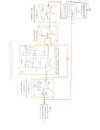I have a pair of old Kinergetic Subwoofers (SW-100) for my stereo, which are long out of production. The speakers came with a passive control box that includes a low pass filter and circuits to compensate for the mechanical structure of the speakers. This was done in an attempt to eliminate "one-note" bass.
The control box is in short supply on the used market and the guy that use to repair them has long since retired. With DSP now more commonly available, I’d like to try and develop a DSP replacement for the control box as a community service.
My background is physics, so I have some familiarity with circuit design, but the “Mechanical Structure Compensation Circuit”, which contains a complicated OpAmp circuit in the feedback loop is beyond my skill level.
I am wondering if anyone is able/willing to help me analyze that circuit? Alternatively, is there an advanced circuits textbook that could push me along?
What I know from reading the patent filings is that this is a feed-forward designed to compensate for cabinet resonances. So, I think this is somewhat analogous to an RIAA correction for an LP.
I am including a copy of the circuits and signal path from the patent filings. I will need to fiddle with the resisters to tune the circuit, but I need to start with an understanding of the circuit.
Thanks for any help anyone can provide, Mike
The control box is in short supply on the used market and the guy that use to repair them has long since retired. With DSP now more commonly available, I’d like to try and develop a DSP replacement for the control box as a community service.
My background is physics, so I have some familiarity with circuit design, but the “Mechanical Structure Compensation Circuit”, which contains a complicated OpAmp circuit in the feedback loop is beyond my skill level.
I am wondering if anyone is able/willing to help me analyze that circuit? Alternatively, is there an advanced circuits textbook that could push me along?
What I know from reading the patent filings is that this is a feed-forward designed to compensate for cabinet resonances. So, I think this is somewhat analogous to an RIAA correction for an LP.
I am including a copy of the circuits and signal path from the patent filings. I will need to fiddle with the resisters to tune the circuit, but I need to start with an understanding of the circuit.
Thanks for any help anyone can provide, Mike

